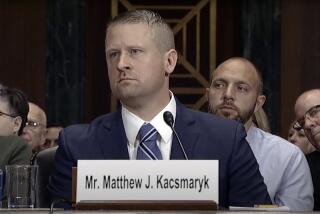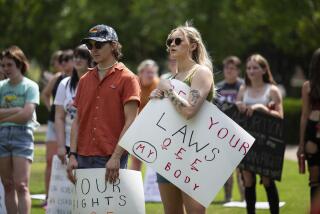Life Doesn’t Begin, It Continues : Abortion Foes Err in Setting Conception as the Starting Point
- Share via
A Missouri statute banning state-funded abortions is now before the U.S. Supreme Court for review. The preamble to the law declares that “ . . . the life of each human being begins at conception.” In overturning that law, the U.S. 8th Circuit Court of Appeals, in St. Louis, called the above statement “. . . an impermissible theory of life . . . .” It contradicts not only the Wade vs. Roe decision, but the most elementary principles of modern biology as well.
Unfortunately, modern biology has also been under severe and continuing attack by creationists, the animal-rights movement, and by the anti-abortion fundamentalists. No wonder that there is an appalling illiteracy abroad on what should have been self-evident for every high-school graduate in the nation. No reasonable person can dismiss the concerns of those who oppose abortion as a religious or ethical issue. But to call first-trimester abortion murder, the taking of a human life, is more an understandable emotional rather than rational response.
Human life begins at conception. This extreme statement, the basis of most of the opposition to abortion, is patently false for a very simple and self-evident reason: Life never stops. It is a continuum that the great French scientist Louis Pasteur in the last century demonstrated in a series of classical experiments. These experiments were the death-knell of the concept of spontaneous generation of life, something that the creationists of today still cling to with such fervor. A woman is born with the full complement of eggs that she will shed, one by one, once a month, throughout her reproductive life. The unfertilized eggs die and are lost, and that is the fate of most of them. By contrast, a man generates spermatozoa by the millions for each ejaculation, and these sperm cells die by the billions during a human lifetime. Fertilization of an egg by a single sperm cell is only possible with the biochemical cooperation of millions of other spermatozoa.
Both the eggs and the spermatozoa are living cells. The main difference between these cells and somatic (i.e. body) cells is that sperm and egg each have only half of the full complement of chromosomes of a somatic cell. The essential point is that life does not begin with a fertilized egg: Life was there all along with the egg and the spermatozoa. The pathway of life is a long and continuous saga, a kind of relay race where fierce and cruel competition is focused on passing the winning chromosomes to the next generation.
A person who burns a house down is an arsonist. But a person who burns only the blueprint of that house is certainly not an arsonist. The fertilized egg is primarily a blueprint that may, and only may, eventually become a human being. Nature destroys fertilized eggs during pregnancy for many reasons: health of the mother as well as potentially serious and fatal defects in the conceptus.
The bringing of a human being into the world is perhaps the most compelling of all ethical considerations involving procreation. Life is an unforgivingly cruel challenge. It should be the responsibility of the procreators to ensure that a new human being will have a fair chance to compete. It is murder to kill a human being with premeditation. Just as burning a house blueprint is not arson, it is reasonable to ask whether the destruction of a fertilized egg can be called murder. Most responsible and thinking persons would not think so.
Ontogeny recapitulates phylogeny. This is a fundamental tenet of modern biology that derives from evolutionary theory, and is thus anathema to creationism as well as to those opposed to freedom of choice. Ontogeny is the name for the process of development of a fertilized egg into a fully formed and mature living organism. Phylogeny, on the other hand, is the history of the evolution of a species, in this case the human being. During development, the fertilized egg progresses over 38 weeks through what is, in fact, a rapid passage through evolutionary history: From a single primordial cell, the conceptus progresses through being something of a protozoan, a fish, a reptile, a bird, a primate and ultimately a human being. There is a difference of opinion among scientists about the time during pregnancy when a human being can be said to emerge. But there is general agreement that this does not happen until after the end of the first trimester. At that point the fetus is less than four inches long and weighs less than two ounces, a long way from being a biologically formed human baby.
These modern biological considerations are crucial factors in deciding what constitutes a new and viable human being. And judging from the 7-to-2 decision of the U.S. Supreme Court on Edward vs. Aguillard, which declared the Louisiana statute imposing creationism in the public-school curriculum unconstitutional, it seems reasonable to suggest that scientific evidence will be taken into consideration by the court in the adjudication of the Missouri statute.






